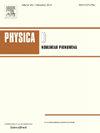通过广义Kuramoto振子的集体动力学学习对称性和非欧几里德数据表示
IF 2.9
3区 数学
Q1 MATHEMATICS, APPLIED
引用次数: 0
摘要
学习数据的低维表示是现代机器学习的核心问题。最近,人们已经广泛认识到一些无处不在的数据集在弯曲流形中比在欧几里得空间中更忠实地表示。这一观察结果激发了非欧几里得深度学习架构的广泛实验。在许多情况下,球面、双曲空间或矩阵流形上的数据嵌入可以实现更紧凑的模型和更高效的算法。在本文中,我们认为Kuramoto模型(包括它们的高维推广)为推断数据的内在曲率和隐藏对称性提供了一个强大的框架。Kuramoto系综自然地编码变换群(如特殊正交群、酉群和洛伦兹群)的作用。经过几十年对Kuramoto模型及其扩展的研究,相应的群论框架已经建立。这为几何知识的架构提供了坚实的理论基础。我们概述了与各种Kuramoto模型相关的球和双曲球的概率分布族。这些概率分布为几何深度学习中不确定性的编码和推理算法的设计提供了统计模型。由于其良好的性质,Kuramoto网络可以通过标准的反向传播方法进行训练。本文章由计算机程序翻译,如有差异,请以英文原文为准。
Learning symmetries and non-Euclidean data representations via collective dynamics of generalized Kuramoto oscillators
Learning low-dimensional representations of data is the central problem of modern machine learning (ML). Recently, it has been widely recognized that some ubiquitous data sets are more faithfully represented in curved manifolds, rather than in Euclidean spaces. This observation motivated extensive experiments with non-Euclidean deep learning architectures. In many setups, data embeddings on spheres, hyperbolic spaces or matrix manifolds enable more compact models and efficient algorithms. In the present paper we argue that Kuramoto models (including their higher-dimensional generalizations) provide a powerful framework for inferring intrinsic curvature and hidden symmetries of the data. Kuramoto ensembles naturally encode actions of transformation groups (such as special orthogonal, unitary and Lorentz groups). Following decades of studies of the Kuramoto model and its extensions, the corresponding group-theoretic framework is well established. This provides a solid theoretical foundation for geometry-informed architectures. We overview families of probability distributions on spheres and hyperbolic balls which are associated with various Kuramoto models. These probability distributions provide statistical models for encoding uncertainties and designing inference algorithms in geometric deep learning. Due to their favorable properties, Kuramoto networks can be trained via standard backpropagation method.
求助全文
通过发布文献求助,成功后即可免费获取论文全文。
去求助
来源期刊

Physica D: Nonlinear Phenomena
物理-物理:数学物理
CiteScore
7.30
自引率
7.50%
发文量
213
审稿时长
65 days
期刊介绍:
Physica D (Nonlinear Phenomena) publishes research and review articles reporting on experimental and theoretical works, techniques and ideas that advance the understanding of nonlinear phenomena. Topics encompass wave motion in physical, chemical and biological systems; physical or biological phenomena governed by nonlinear field equations, including hydrodynamics and turbulence; pattern formation and cooperative phenomena; instability, bifurcations, chaos, and space-time disorder; integrable/Hamiltonian systems; asymptotic analysis and, more generally, mathematical methods for nonlinear systems.
 求助内容:
求助内容: 应助结果提醒方式:
应助结果提醒方式:


